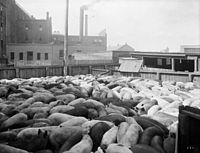
Back صناعة تعبئة اللحوم Arabic Мясная прамысловасць Byelorussian Produkce masa Czech Kødproduktion Danish Fleischproduktion German Viandindustrio Esperanto Industria de procesamiento de la carne Spanish Lihatööstus Estonian Haragia prozesatzeko industria Basque صنعت بستهبندی گوشت Persian

The meat-packing industry (also spelled meatpacking industry or meat packing industry) handles the slaughtering, processing, packaging, and distribution of meat from animals such as cattle, pigs, sheep and other livestock. Poultry is generally not included. This greater part of the entire meat industry is primarily focused on producing meat for human consumption, but it also yields a variety of by-products including hides, dried blood, protein meals such as meat & bone meal, and, through the process of rendering, fats (such as tallow).
In the United States and some other countries, the facility where the meat packing is done is called a slaughterhouse, packinghouse or a meat-packing plant; in New Zealand, where most of the products are exported, it is called a freezing works.[1] An abattoir is a place where animals are slaughtered for food.

The meat-packing industry grew with the construction of railroads and methods of refrigeration for meat preservation. Railroads made possible the transport of stock to central points for processing, and the transport of products.
- ^ Noted. "Following the call of New Zealand's abandoned freezing works". Noted. Archived from the original on 2019-05-25. Retrieved 2019-06-19.